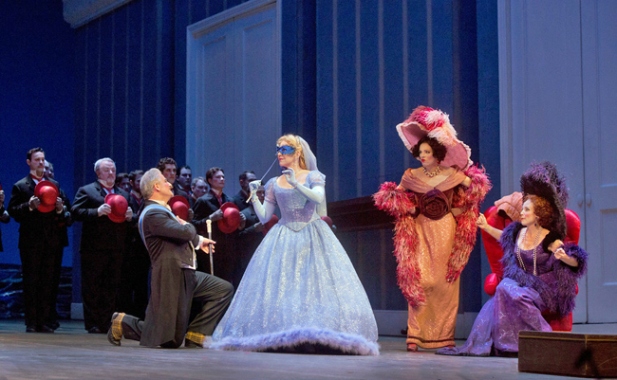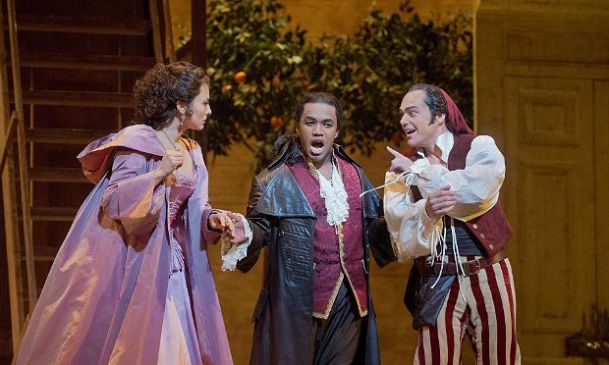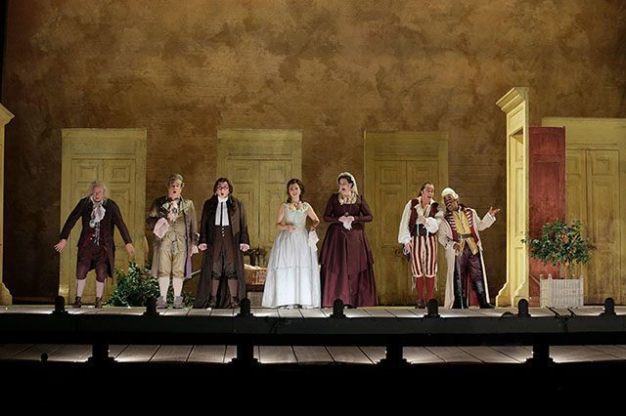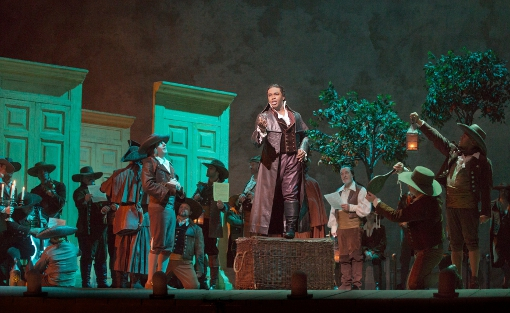When One Season Ends, Another Begins
That’s how it is with opera: as soon as we marvel at how well the cream of the bel canto crop has performed on the air, along comes a production that completely undoes whatever positive impressions came before.
I’m referring to an once-in-a-lifetime transition whereby the 2013-14 Metropolitan Opera radio season ended with a bang with Gioachino Rossini’s La Cenerentola, the Italian version of the Cinderella story, while the 2014-15 season began with a thud via the broadcast of the same composer’s The Barber of Seville. Two comic-opera delights which, on paper, featured ideal casts — yet only one of them came out holding the glass slipper, or gold bracelet in the case of Rossini’s work.
Let’s discuss that work, the May 10th broadcast of La Cenerentola starring the fabulously gifted American mezzo-soprano Joyce DiDonato as Angelina, our fairy-tale heroine and a major interpreter of this repertoire. The other cast members included bel canto specialist Juan Diego Flórez as Don Ramiro (or Prince Charming), Luca Pisaroni as Alidoro, Alessandro Corbelli as Don Magnifico (the mean stepfather), Pietro Spagnoli in his broadcast debut as Dandini, and Rachelle Durkin and Patricia Risley as, respectively, the vain stepsisters Clorinda and Tisbe. The conductor for the afternoon was Fabio Luisi, the Met’s principal podium master.
This 1997 production is by Cesare Lievi, with charming box sets and costumes by designer Maurizio Balò. As any follower of this infectious piece knows, Rossini and his librettist, Jacopo Ferretti, grounded their adaptation of Charles Perrault’s enduring tale less in the magical arena and more in the everyday drudgery of its title character. Not that enchantment was banished altogether from this realm, but instead of the usual “hocus-pocus” and “bibbidy-bobbadi-boo” prestidigitations we have the behind-the-scenes intrigue of Ramiro’s wise tutor, Alidoro, who takes on the gutsy role of the Fairy Godfather (not Godmother), but sans magic wand.
Angelina, as she’s called here, wins the hand of her prince through a kind and loving heart as well as modest displays of sympathy and largesse for her loutish step-parent, Don Magnifico, and his two insipid daughters. This is as it should be, for the subtitle of the piece, “ossia la bontà in trionfo” (“or the triumph of goodness”), tells listeners all they need to know about this kind-hearted character’s motives. As corny as it may sound, Monsieur Perrault, the creator of the original tale, and Walt Disney himself I daresay, would have approved of these harmless alterations.
What matters most, of course, is the music, which follows the general pattern of Rossini’s earlier The Barber of Seville — i.e., fast tempos, rapid-fire ensembles, and soft-to-loud passages — and how it enhances or detracts from our enjoyment of the piece, whether or not it was successfully transmitted by the artists involved. On that front, we need have no concerns, for this performance of La Cenerentola proved to be one of the Met’s finest to date.
Ms. DiDonato, who debuted at the house in 2005-06, has been performing the Rossini catalogue for nearly two decades. Ergo, her spirited Angelina is one of this singer’s premium assignments, a role she has vested with personality, affinity and persuasiveness at every turn. Physically, she personifies both the scullery-maid aspects as well as the “storybook princess” elements called for in the text. Her joyful second act rondo, “Non piu mesta accanto al fuoco” (“Now farewell, dark days of weeping”), which readers may recall was borrowed from Rossini’s Barber, was a vocal triumph of the first order. All her roulades and repeats, along with runs up-and-down the scale, were carried out with refinement and skill, as worthy a depiction of her artistry as any I’ve heard to date.
DiDonato was deftly seconded by her partner, Peruvian tenor Juan Diego Flórez, one of only a handful of artists at the Met (the others being Javier Camarena and Lawrence Brownlee) who have successfully maneuvered through the vocal rigors of Prince Ramiro’s tricky tessitura. It’s not just about hitting the notes that have made this singer (and the above-mentioned team of performers) so special but his knack for conveying a regal demeanor combined with ease of flow, while also spewing forth those abundant Cs and Ds in alt.
Lately, Juan Diego has been venturing into heavier tenor repertory. We need not fear for his vocal life, however, since the heaviest he’s been involved with (so far) is Rossini’s Arnold in Guillaume Tell. And from all reliable reports, he has acquitted himself with honor. Fortunately for the listener, Flórez has kept that nimbleness and buoyancy throughout his range, absolute requisites in this preeminent company. He and Ms. DiDonato are two artists who never seem to force their naturally lyrical instruments to points beyond their limits. To find and hear such savvy professionals in this day and age is a wonder indeed; that they were accompanied by singers of near-equal stature is more than we can expect.
It’s certainly been proven that a native Italian, in those mile-a-minute Rossinian patter songs, with rare exceptions can manipulate those arias’ complicated lyrics better than most non-Italians. And audiences were blessed with not two but THREE such sturdy talents: the bassos Pisaroni, Corbelli and Spagnoli. Alidoro is the mover and shaker of the piece, and Signor Pisaroni, whom I’ve heard previously in Handel and Mozart, was fluid in his runs and exceedingly adept at both the highest and lowest ranges of this part.
The same can be said for Signor Corbelli, a full-voiced, plumy buffo in the tradition of Fernando Corena and Paolo Montarsolo, but with a lighter timbre more reminiscent of baritone Renato Capecchi — a singer well acquainted with tragic and comic parts. New to me was Signor Spagnoli, who complemented these fine gentlemen as a vocally commanding Dandini. We can thank Rossini for that: he’s provided his lower-voiced characters with an embarrassment of riches in this work — take your pick of the litter, fellows!
The two stepsisters, sung by Durkin and Risley (sounds like an ambulance-chasing law firm, doesn’t it?) played their parts to risible perfection. Maestro Luisi let the music flow, with plenty of snap, crackle and pop in the pit and in the immensely satisfying ensembles, of which there are plenty. His attention to detail and knowledge of how this work should be played and sound assisted in bringing down the curtain on a most magical season replete with luscious gardens of vocal delights.
The Forecast: Dull with Continuing Dullness
So what happened between May and December? Something must have gotten lost in translation during the long summer-to-fall hiatus. I am still trying to wrap my arms around the meager quality of the Met’s The Barber of Seville broadcast of December 6, 2014, the first of the Saturday afternoon 2014-15 radio transmissions.
Perhaps it was the flu that got everybody bugged, or maybe a really bad case of repertory negligence. Whatever the reason, there was no excuse for the piteous display of vocalism that ran rampant during this Bartlett Sher production of one of the repertoire’s best-loved masterworks.
A notorious failure at its 1816 premiere, under the banner of Almaviva, ossia l’inutil precauzione (“Almaviva, or the Useless Precaution”) so as not to conflict with an earlier adaptation by composer Giovanni Paisiello, Il Barbiere di Siviglia, to cite its original Italian title, was based on a trilogy of plays by French dramatist Pierre-Augustin Caron de Beaumarchais, whose The Marriage of Figaro (the second work in the trilogy) became the basis for Mozart’s Le Nozze di Figaro.
While Paisiello’s opera was still being lauded, Rossini and his collaborator, the poet Cesare Sterbini, decided to rework Paisiello’s piece, much to the dismay of his followers, to include Signor Paisiello himself. That infamous fiasco of February 20th when The Barber premiered at the Teatro Argentina in Rome has been thoroughly discussed by scholars ad absurdum, its faults explored and re-examined as to why the work flopped at the outset.
As near as can be determined, the performers were thrown off by the audience’s negative reaction to what they heard and saw; that is to say, not so much by the music itself as to the lack of polish on the part of those same performers. That may sound like heresy to readers, but it was a common situation during those raucously unsound times. Verdi and Wagner — and Puccini, too, if truth be told — had to contend with any number of disruptive forces, among them unruly patrons, inferior casts, listless conducting, substandard playing, and subpar surroundings.
Our modern expectations of professionalism and the superior degree of musicianship that, today, has been taken for granted were in short supply back then, even in such esteemed institutions as La Scala and Bayreuth. Rossini, Donizetti, and Verdi and their ilk, along with an army of musicians slaving away in the “galleys” as they were known, faced this problem on a daily basis. About the best they could do was to deal with the lack of preparedness head-on and as the issue arose. Would that some of their spunk and ingenuity to overcome the many hurdles thrust upon them have rubbed off on their present-day counterparts!
With that lead-in in mind, the broadcast of The Barber of Seville featured the redoubtable Lawrence Brownlee as an extremely accomplished Count Almaviva, Christopher Maltman as the jack-of-all-trades Figaro, Maurizio Muraro as a tongue-tied Dr. Bartolo, Isabel Leonard as his ward Rosina, and Paata Burchuladze as the mealy-mouthed music master Don Basilio. Michele Mariotti was the conductor for this performance and, as we’ve noted in prior posts, the haste-makes-waste maestro whose fast-paced leadership of this and other bel canto works lent considerable verve to the proceedings, if without pause for respite.
That’s not to say that artistry was left in the dust, but on this broadcast I got the impression that some of Saturday’s participants were “winging it” on their own. I’ve mentioned before about presenting complete performances of standard and non-standard bel canto items, which has much improved over the years, especially with regard to early and middle-period Verdi.
With Rossini’s Barber, the more there is of this piece, the better-sounding it becomes (to me, at least). Small cuts here and there, such as the brief scene with Fiorello after Figaro and Almaviva’s three-quarter-time duet in Act I, scene i; the comic interplay earlier on with Dr. Bartolo and Rosina at her balcony; or the extended exchange between Bartolo, the sneezing Berta and a yawning Ambrogio, while providing grist for the slapstick-comedy mill, can be easily dispensed with and suffer no damage to the overall plot.
A Matter of Casting
But the biggest bone I have to pick is some of the slipshod quality of the major performers themselves, by which I mean the egregious casting of Paata Burchuladze as Basilio and the blustering Bartolo of Maurizio Muraro. In last year’s discussion of J.D. McClatchy’s English-language version of the opera (see the following link: https://josmarlopes.wordpress.com/2013/01/02/opera-review-the-barber-of-seville-in-english-shave-and-a-haircut-two-bits/), I complained furiously about his translation as not being riotous enough or nearly as intelligible to novices as it needed to have been.
This time, I found grievous fault with Burchuladze’s vocal mannerisms, which were abysmally below the expected level for an artist of his longevity and repute. His rise to prominence in the 1980s and subsequent appearances with Luciano Pavarotti and Herbert Von Karajan, in addition to participation in various Verdi performances at La Scala and thereabouts, paved the way for his 1989 Met debut as Ramfis in Aida. A solo recording of scenes from Russian and Italian opera (well received, but with reservations as to his lack of dramatic thrust), as well as DVDs of La Scala performances, fueled the notion that here was another Fyodor Chaliapin in the making. Uh, not quite!
One critic claimed his Don Basilio was better acted than sung, which may have given rise again to comparisons with Chaliapin. This is disparaging to Chaliapin, who until a ripe old age had a superbly disciplined and mellifluous voice, preserved for us on old 78s and on film. The unfulfilled promise of the once-potent Paata, however, who struggled with both ends of Basilio’s “La calunnia” — normally, a sure-fire showstopper for any bass worth his low F — spilled over into Mr. Muraro’s undisciplined, sloppy, and irritating interpretation of Bartolo’s “A un dottor della mia sorte” (“A doctor of my reputation”).
Artists of the caliber of Salvatore Baccaloni and Melchiorre Luise, Corena and Montarsolo, Sesto Bruscantini, Enzo Dara, Angelo Romero, or this country’s John Del Carlo, have all executed this vocal tirade with more panache and comic timing than Muraro could muster. To top it off, he concluded the torturous piece by gasping for air while wavering perilously off pitch. This could have been part of the show, but on the radio Muraro sounded over-parted.
In like manner, Burchuladze’s stab at an unwritten high note to “La calunnia” was calumnious in itself, in the way it completely blew the composer’s cadenza to the four winds. And to think he was following in the illustrious footsteps of such past luminaries as Chaliapin, Ezio Pinza, Tancredi Pasero, Cesare Siepi, Giulio Neri, Italo Tajo, Nicolai Ghiaurov, Samuel Ramey, and Ferruccio Furlanetto. Ah, it pains the ear…
In this company, Mr. Maltman’s sharply refined Figaro and Ms. Leonard’s neatly vocalized but mature-sounding Rosina, escaped the bad notices, but neither did they shine as they normally would have. I did like Maltman’s basic timbre, though, which was right for the playful town barber; but Leonard’s inability to convey exuberance on the radio was disheartening.
The best performance of the day, dear readers, I have saved for last: Lawrence Brownlee outshone his colleagues with a masterfully phrased, delectably sung and ingratiating traversal of the wily Almaviva whose name, as translated, means “lively soul.” That he was! Although short of stature, Brownlee gave a master class in Italian diction and coloratura leaps and runs. He was also an estimable ensemble player who put to shame some of the so-called veterans on display in that vast Met Opera auditorium. I can’t say enough good things about this enthralling young artist, one of the finest interpreters of bel canto anywhere.
Brownlee, an African American tenor from Youngstown, Ohio, has made a specialty of this repertoire. He stands out from the not-so-crowded field of contenders by talent and ability alone, as one of the opera world’s most sought-after voices.
Thus, Brownlee both ended and began another Met Opera broadcast season in fine fettle; likewise, we should consider ourselves privileged to have heard the likes of Javier Camarena and Juan Diego Flórez, mentioned in the same breath as Brownlee. And may we continue to hear more of these supremely confident young artistes.
In an historic meeting of the minds, Beethoven once urged Rossini to “Remember to give us more Barbers.” I say to the Met, “Remember to provide the singers capable of singing them!”
Copyright © 2014 by Josmar F. Lopes







You must be logged in to post a comment.